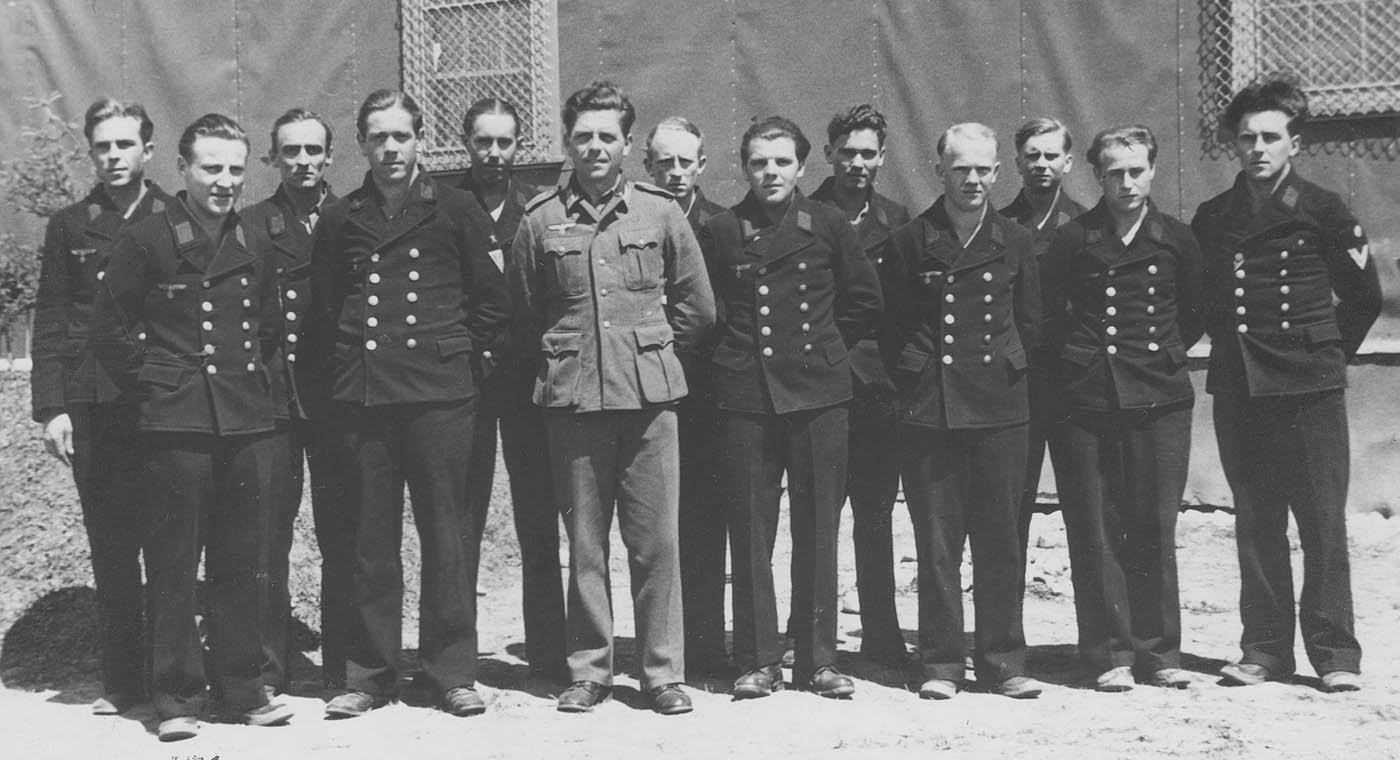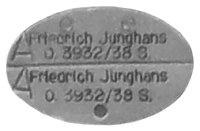| |
 |
|
|
|
| |
 |
Able seaman
Friedrich Junghans
Turret Dora, 7. Division
* 6.6.1919 in Oberwürschnitz (Kingdom of Saxony) - † 28.10.1973
|
 |
|
|


Germany (1919)
Sources:
Kennedy Russell (great-granddaughter) / USA
Peter Higgins (son ofn Stanley A. Higgins) / Great Britain
myheritage.de
|
Friedrich Junghans was born on June 6, 1919 in the Saxon village of Oberwürschnitz in the Ore Mountains. His home village was between Zwickau and Chemnitz on the course of the river Würschnitz. In 1934, the community of 3,000 inhabitants was incorporated into Neuwürschnitz. He grew up here and attended school. But it didn't seem to keep him here. In search of adventure, Friedrich Junghans probably signed up with the merchant marine at the age of 14. Three years later, he sailed on the Hapag passenger ship New York.1 In Hamburg, he boarded the ship as a sailor on May 12, 1936 and now sailed in the transatlantic shipping service between Hamburg and New York. The 207 m long New York was the flagship of the Hamburg shipping company and carried up to 960 passengers in three classes with a crew of around 420 to 460 men. By the end of the year, Friedrich Junghans had taken part in nine North Atlantic crossings. This was an average of one trip per month. In the spring of 1937, the New York sailed four times on West Indies cruises through the Caribbean. Friedrich Junghans made two more Hamburg - New York trips in April and May before leaving the ship after a year on board. He had meanwhile volunteered for the Navy and was accepted for the following year. It is possible that he completed the Labor Service (Reichsarbeitsdienst) in the meantime.
|
|
 Survivors of the Bismarck in Canadian captivity at prisoner of war camp 23 Monteith, Ontario, photographed in June 1942. From left to right:
1. Friedrich Junghans, 2. Rudi Römer, 3. Gerhard Raatz, 4. Erich Wollbrecht, 5. Helmut Behnke, 6. Albert Hülsmann (Army), 7. Fritz May, 8. Heinz Heinecke, 9. Rudi Siste (not from the Bismarck), 10. Alfred Scheidereiter, 11. Herbert Prinke, 12. Herbert Jahn, 13. Bruno Rzonca |
|
1 The crew lists of the immigration authorities in New York City documented the crews of all incoming ships and repeatedly mention the seventeen-year-old Ordinary Seaman Friedrich Junghans from the steamship New York, who is most likely the same person.
2 The 7th Division consisted of the "functionaries", such as Schumacher or Schneider, so it seems unlikely that Friedrich Junghans served in this division.
3 Friedrich Helms, a gunner from Turret Dora who survived later, suffered burns when a hit near the turret blew off the cover of an ammunition receiving hatch and a jet of flame shot up. Friedrich Junghans may also have been wounded in the incident.
|
In 1938, Friedrich Junghans joined the Navy. He was first trained as a soldier during basic training. It is not known which commands he was subsequently given. As a trained merchant seaman, he must have found it easier to get used to the daily routine on board a warship than his comrades. Friedrich Junghans' last command took him to the battleship Bismarck. Here he was assigned to the gun turret Dora and supposedly served in the 7th Division2. It is not known whether, like most young recruits to the seaman's staff, he was first assigned to the barge New York, his old ship from the merchant marine days, which was now in service with the Kriegsmarine. He went on a combat mission with the Bismarck in May 1941. Friedrich Junghans experienced his baptism of fire in the battle with the HMS Hood. A few days later, the Bismarck was rendered unmaneuverable by the Royal Navy. On May 27, 1941, she found herself in a battle against superior British forces. Friedrich Junghans and his comrades knew that this would be their last battle. They returned fire as long as they could. At first, the heavy artillery fired under the direction of the main artillery control center. However, when this, along with the front turrets, was hit, the aft artillery fire direction center took over control. But this too was soon hit by a shell on its optics and so the rear turrets had to fire independently. Friedrich Junghans's Dora turret failed about half to three quarters of an hour after the start of the battle. The right barrel bursted. After that, the left barrel fired two more shots until the report came from below that the turret was on fire. Friedrich Junghans then left the Dora turret together with the entire still unharmed turret crew. The barrels pointed to port, in the direction they had last fired. The outside of the turret was blackened with smoke from the fire. Along with the rear turrets, the Bismarck's gunfire also died out in the unequal fight. Friedrich Junghans survived the ongoing artillery fire, wounded3. It is possible that his turret offered him cover from the impacts and prevented anything worse from happening.
Finally he went into the water and after a long swim he was rescued by the British cruiser HMS Dorsetshire. A stoker named Stanley A. Higgins helped him on board. The exhausted rescued german sailors were wrapped in blankets and led below deck. Friedrich Junghans was completely out of breath and just kept saying: "Whisky ... Whisky". His rescuer replied: "You'll be lucky, we don't get any of that ourselves!!!"
|
|
|
4 As a prisoner of war he was always well treated.
|
 Friedrich Junghans later thanked his rescuer and gave him his dog tag as a thank you. For him and the other survivors, a long period of captivity began. He spent the longest time in Canadian camps. After the end of the war, he had to wait some time for his repatriation and initially had to do compensation service in Great Britain. He probably did not return to his homeland in Saxony, which was now part of the Soviet occupied zone and later the GDR, but moved to Hamburg. There he worked, among other things, as captain of an Alster steamer, one of the traditional excursion ships on the large Hamburg inland waters. He married his fiancée Charlotte and had a son, Roland, and a daughter, Heidegard. Friedrich Junghans decided to emigrate to Canada with his family in the 1950s. He had very fond memories of the country and its people4 from his time in captivity. The family found a new home in Fort William in Ontario, a district of the city of Thunder Bay on Lake Superior near the US border. Friedrich Junghans worked as a coal miner. To assimilate more easily, he later used the English spelling of his name Frederick. After emigrating, his youngest son, Norman, was born.
Friedrich Junghans later thanked his rescuer and gave him his dog tag as a thank you. For him and the other survivors, a long period of captivity began. He spent the longest time in Canadian camps. After the end of the war, he had to wait some time for his repatriation and initially had to do compensation service in Great Britain. He probably did not return to his homeland in Saxony, which was now part of the Soviet occupied zone and later the GDR, but moved to Hamburg. There he worked, among other things, as captain of an Alster steamer, one of the traditional excursion ships on the large Hamburg inland waters. He married his fiancée Charlotte and had a son, Roland, and a daughter, Heidegard. Friedrich Junghans decided to emigrate to Canada with his family in the 1950s. He had very fond memories of the country and its people4 from his time in captivity. The family found a new home in Fort William in Ontario, a district of the city of Thunder Bay on Lake Superior near the US border. Friedrich Junghans worked as a coal miner. To assimilate more easily, he later used the English spelling of his name Frederick. After emigrating, his youngest son, Norman, was born.
|
|
|
5The lung cancer was probably a result of his work as a miner in the coal mines; Friedrich Junghans was also a smoker.
|
He never spoke much with his family about the traumatic experiences of the war. Later, the family moved to the USA, where he died of lung cancer5 on October 28, 1973, at the age of 54. He was buried in Rose Hills Memorial Park in Whittier in Los Angeles County. Stanley A. Higgins, his former rescuer, had hoped to meet him at a joint memorial event for the survivors of the Bismarck and the HMS Dorsetshire on May 27, 1974 in Friedrichsruh near Hamburg. He wanted to use this opportunity to give him back the dog tag that Stanley A. Higgins had kept for all these years. As this was unfortunately no longer possible, he eventually donated the dog tag to the Merseyside Maritime Museum in Liverpool, where it is still on display today together with his own oil-stained life jacket, which Stanley was wearing when the HMS Dorsetshire was sunk in the Indian Ocean in 1942.
|
|
|